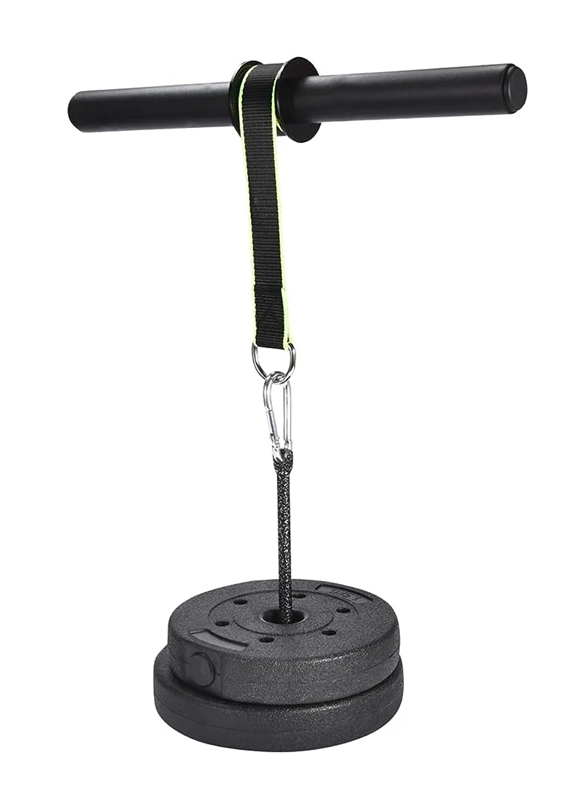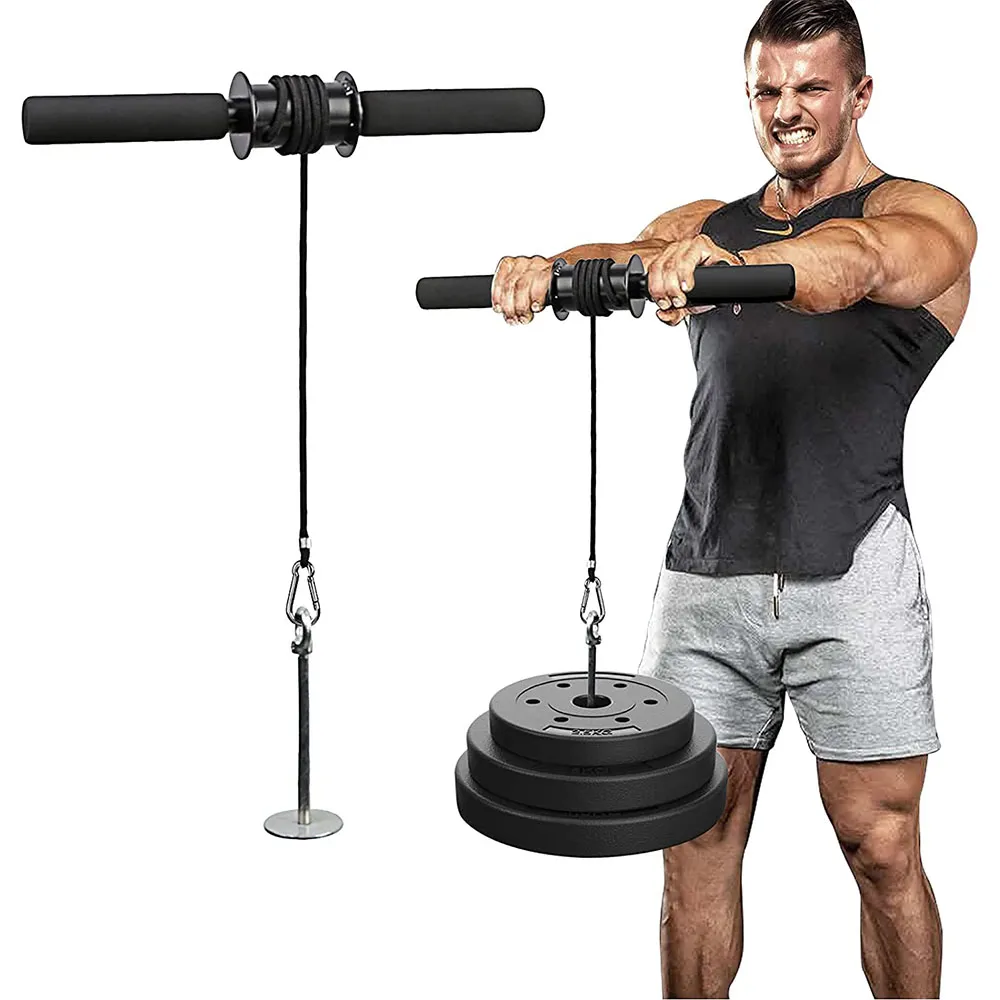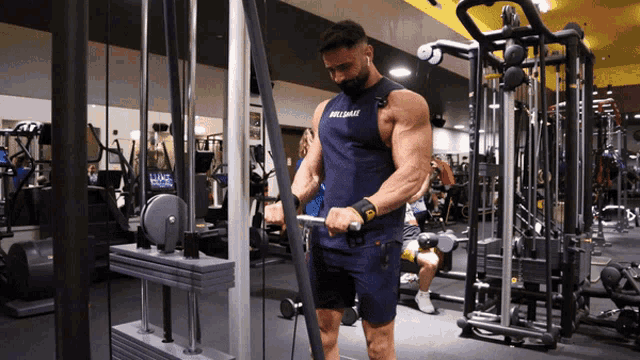Wrist Roller (Grip & Extensor Strength): The Forgotten Forearm Finisher
The Wrist Roller is an old-school, brutally effective forearm developer that’s been around since the golden age of bodybuilding — and for good reason. It’s simple, primal, and devastatingly effective at building raw grip strength, forearm size, and muscular endurance.
Unlike isolation movements like wrist curls or reverse curls, the wrist roller targets both the flexors and extensors, creating balanced forearm development and iron grip control.
It’s the perfect “finisher” exercise to cap off an arm or pull session — leaving your forearms swollen, pumped, and trembling.
For bodybuilders, powerlifters, and athletes alike, the wrist roller bridges the gap between aesthetic development and functional strength. It’s a must-have if you want forearms that not only look strong, but perform strong.
Muscles Worked
Primary Muscles:
- Wrist Flexors – located on the inner forearm; responsible for curling the wrist downward.
- Wrist Extensors – located on the outer forearm; control wrist extension.
Secondary Muscles:
- Brachioradialis – major forearm muscle responsible for elbow flexion.
- Brachialis – assists in elbow flexion and arm thickness.
- Finger Flexors and Extensors – grip and stabilization.
- Deltoids and Core (stabilizers) – help maintain arm position during rolling.
💡 Anatomical Insight:
The wrist roller is one of the few exercises that equally challenges both the flexors and extensors. This prevents forearm imbalance and keeps the wrists healthy — vital for longevity in training.
Why Bodybuilders Use the Wrist Roller
- Total Forearm Development
- Builds both the inner (flexors) and outer (extensors) forearm muscles.
- Improves Grip Strength
- Directly translates to better performance on heavy lifts like deadlifts, rows, and pull-ups.
- Enhances Endurance and Control
- Builds muscular stamina for longer sets and improved bar control.
- Prevents Imbalances
- Balances pushing and pulling muscle groups in the lower arm.
- Aesthetic Density and Vascularity
- High time-under-tension builds deep muscular striations and promotes forearm vascularity.
- Minimal Equipment, Maximum Effect
- All you need is a wrist roller, a rope, and a plate — making it perfect for home or gym use.
How to Perform the Wrist Roller
Setup
- Use a wrist roller device (a short bar with a rope and weight plate attached).
- Stand upright with feet shoulder-width apart.
- Hold the bar with both hands at shoulder height, palms facing down (overhand grip).
- Keep your arms straight and parallel to the floor.
Execution
- Rolling Up (Concentric Phase)
- Rotate one wrist at a time, rolling the rope around the bar to lift the weight upward.
- Maintain steady, controlled wrist rotation — avoid jerky movements.
- Keep your shoulders and elbows locked in position.
- Rolling Down (Eccentric Phase)
- Once the plate reaches the top, slowly reverse the motion, letting the rope unwind under control.
- Keep tension constant until the plate gently touches the floor.
Key Form Cues
✅ Maintain a neutral spine — no leaning back or hunching forward.
✅ Keep the bar level and arms fully extended.
✅ Move only your wrists — not your shoulders or elbows.
✅ Control the descent to maximize time under tension.
✅ Don’t rush — the slower you roll, the greater the burn.
Common Mistakes and Fixes
| Mistake | Issue | Fix |
| Using momentum | Reduces muscular tension | Slow, controlled wrist rotation only |
| Bending elbows | Shifts tension away from forearms | Keep arms straight and parallel to floor |
| Leaning back excessively | Reduces isolation and adds risk | Engage core, keep torso stable |
| Dropping weight too fast | Misses eccentric loading | Control the lowering phase |
| Using too heavy a plate | Limits range and control | Start light and focus on endurance |
Programming for Growth and Strength
For Hypertrophy (Size & Pump)
- Sets: 3–4
- Reps: Roll up + roll down = 1 rep
- Weight: Moderate (enough for 30–40 seconds of tension)
- Rest: 60–90 seconds
For Grip & Endurance
- Sets: 3
- Time: 45–60 seconds per set
- Rest: 45 seconds
- Focus on continuous rolling without breaks.
For Strength
- Sets: 4
- Weight: Heavy (plate challenging by the halfway mark)
- Tempo: Controlled — 2–3 seconds per wrist turn
- Rest: 2 minutes
Training Strategies from a Bodybuilder’s Perspective
💪 End Every Arm Workout with It
The wrist roller makes an excellent finisher — flood your forearms with blood and finish strong.
💪 Focus on the Burn, Not the Load
The goal is time under tension, not ego lifting. Use a plate that lets you move smoothly.
💪 Alternate Grip Positions
Switch between overhand and underhand every few sets to target both flexors and extensors equally.
💪 Stay Strict
Keep arms locked out and avoid leaning — this isolates the forearms perfectly.
💪 Control the Descent
The lowering phase is where growth happens. Don’t let gravity do the work.
Variations
- Overhand Grip Wrist Roller
- Standard version emphasizing wrist extensors (top of forearm).
- Builds outer forearm hardness and detail.
- Underhand Grip Wrist Roller
- Palms facing up — emphasizes wrist flexors (inner forearm).
- Perfect for building the meaty underside of the forearm.
- Seated Wrist Roller
- Sit and brace forearms on your thighs while rolling.
- Excellent for strict isolation and beginners.
- Behind-the-Back Wrist Roller
- Hold the bar behind you, palms facing backward.
- Intense variation for advanced lifters emphasizing forearm flexors.
- Cable Wrist Roller
- Use a low pulley instead of a hanging rope for constant resistance.
- Great for controlled hypertrophy-focused sets.
Advanced Techniques for Maximum Forearm Development
- Superset Finishers
- Pair reverse curls or hammer curls with the wrist roller.
- Example: 3×15 Reverse Curls → 1 set Wrist Roller Burnout.
- Drop Weight Sets
- Reduce plate weight mid-set to extend time under tension.
- Time-Based Challenges
- Set a timer for 60–90 seconds — see how long you can keep the plate moving.
- Iso-Hold Challenge
- Hold the plate at mid-air for 10 seconds before lowering.
- Volume Ladder
- Start with 1 roll up and down, rest 10 seconds, add one more roll each round up to 5. Brutal and effective.
Integrating the Wrist Roller Into Your Training
As a Finisher (Best Use)
Perform 2–3 rounds of the wrist roller at the end of your arm or back session for a final pump.
Example:
- Barbell Curl – 4×10
- Hammer Curl – 3×12
- Reverse Curl – 3×15
- Wrist Roller – 3 rounds to failure
On Grip Training Days
Pair the wrist roller with farmer’s carries or plate pinches for comprehensive forearm and grip conditioning.
Example:
- Farmer’s Carry – 3×30 seconds
- Plate Pinch Hold – 3×20 seconds
- Wrist Roller – 3×1 up/down sets
In a Full-Body Program
Use the wrist roller 2× per week after compound lifts to maintain grip and joint balance.
Forearm Development Benefits
| Benefit | Description |
| Hypertrophy | Constant tension promotes muscle growth and vascularity |
| Endurance | Improves ability to maintain grip over longer workouts |
| Symmetry | Balances flexors and extensors |
| Injury Prevention | Strengthens tendons and stabilizers in wrists and elbows |
| Performance | Directly enhances pulling, pressing, and gripping lifts |
Bodybuilder Insights
🏆 Arnold Schwarzenegger often finished arm workouts with wrist rollers, chasing the “ant-burning” forearm pump.
🏆 Dorian Yates used it to strengthen grip for heavy deadlifts and back training.
🏆 Larry Scott, the first Mr. Olympia, believed that wrist rollers were key to achieving “complete” arm development from elbow to wrist.
It’s an exercise the old-school greats swore by — and for good reason. It works.
Safety & Recovery Tips
⚠️ Don’t overload too early — the forearms fatigue quickly.
⚠️ Use smooth, controlled movement to protect the wrists.
⚠️ Stretch the flexors and extensors after training to maintain mobility.
⚠️ Incorporate extensor work (reverse curls) to avoid tendonitis.
⚠️ Limit to 2–3 sessions per week to prevent overtraining the smaller muscles.
Hammer Curl vs Wrist Roller Comparison
| Exercise | Focus | Benefit |
| Hammer Curl | Brachialis & brachioradialis | Size & arm thickness |
| Wrist Roller | Forearm flexors & extensors | Grip strength & endurance |
Using both creates total lower-arm development — strength, size, and symmetry.
Practical Takeaways
✅ Use as a finisher 2–3× per week for complete forearm development.
✅ Roll slowly and under control — both up and down.
✅ Keep arms straight and avoid leaning or swinging.
✅ Alternate grip directions to hit flexors and extensors equally.
✅ Prioritize time under tension over heavy weight.
Conclusion
The Wrist Roller is one of the most brutally effective yet criminally underrated exercises in arm training. It’s the definition of simplicity with purpose — a single tool that forges forearm power, grip endurance, and muscle balance like nothing else.
If your goal is to build forearms that look strong and perform strong, this old-school tool should be in your arsenal.
It’s not glamorous, but it’s timeless — a throwback to when training was raw, real, and built on discipline.
Roll. Burn. Repeat.
That’s how legends built their forearms — and how you’ll build yours.





